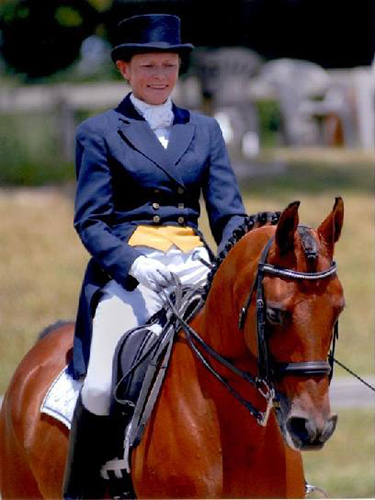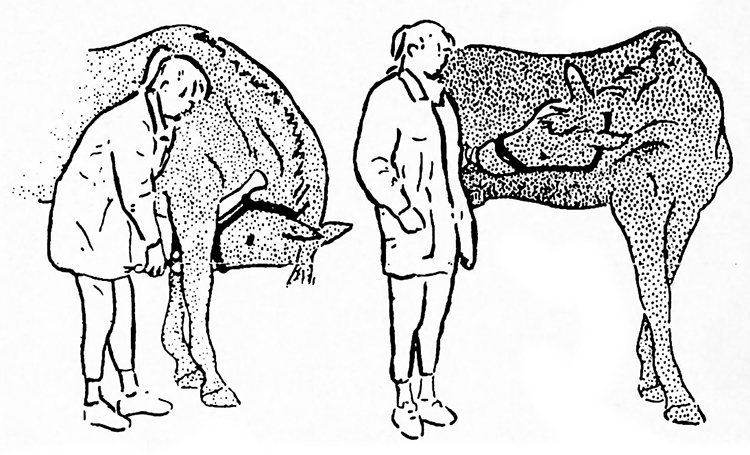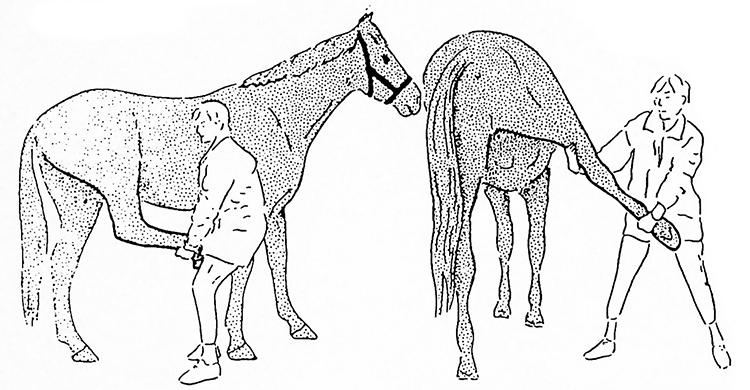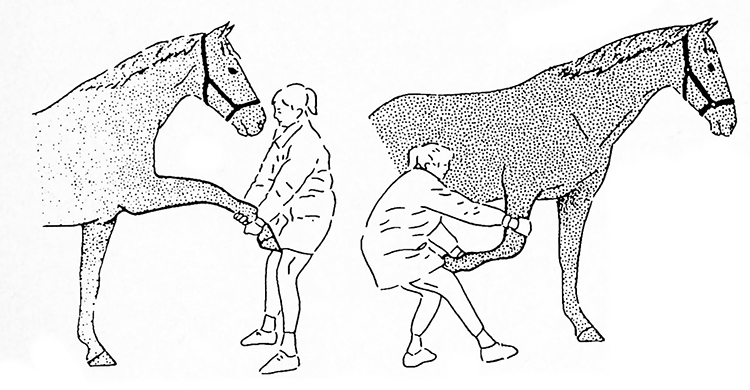 Hilary Clayton combines her own love of horses and riding, with a rigorous scientific approach that over the last 30 years has showed how superstition and guesswork can be replaced by clear logical thought…
Hilary Clayton combines her own love of horses and riding, with a rigorous scientific approach that over the last 30 years has showed how superstition and guesswork can be replaced by clear logical thought…
PASSIVE SUPPLING – slow controlled movement to the limit of joint motion through the action of an external force
DYNAMIC SUPPLING – rapid movement of a joint due to active muscular contraction or weight-bearing
For the most part suppling exercises are directed toward the shoulders, hips and vertebral column. In working through a series of suppling exercises, it is recommended that the major joints of the neck and back be worked on first, progressing to the upper limbs and finally the lower limbs. Suppling exercises are described as passive or dynamic; both types are useful and effective in horses.
Passive Suppling
Passive suppling involves a slow, controlled movement of a joint to the limit of its range of motion through the application of an external force. Because the force is applied slowly it avoids stimulating the myotatic stretch reflex, which would result in muscular tension opposing the stretch. When the limit of movement in a particular direction is reached, the stretched position is held for 20 seconds to enhance permanent elongation of the ligaments, tendons and joint capsules. Passive suppling is used as an adjunct to dynamic suppling to bring about long term increases in the range of motion in the neck, shoulders and hips, and to promote relaxation and reduce post-exercise muscular soreness. As with all types of suppling exercises, the tissues should be warmed up before passive suppling is performed. This is best accomplished by a period of exercise under saddle or on the lunge, which means that it is more appropriate to perform passive suppling during or after, rather than before, a workout.
Ventral flexion of the neck is accomplished with the aid of a tidbit held between the horse’s front legs. As suppleness improves, the horse will be able to take his nose further down and back between the legs. For lateral bending the tidbit is held at the side of the trunk behind the girth. As the horse gets more supple it will reach further back toward the stifle. Strictly speaking these are not passive suppling exercises because the movement is controlled by the horse’s muscular activity. However, they are easily integrated into the passive suppling routine.

Ventral and lateral bending of the neck
The shoulder region and the hip joints are stretched in all directions using a series of passive suppling exercises. The horse should be in a quiet environment, and standing squarely before starting. It is safer if the horse is held by an assistant rather than being tied up. The person performing the stretches should have plenty of room to move around on all sides of the horse. Suppling of the shoulder region involves moving the front leg to the limit of its range of motion forward, backward, laterally and medially, and holding each stretched position for several seconds. The front leg is pulled forward slowly to stretch the elbow and shoulder, keeping the knee slightly bent to relieve tension in the flexor tendons and suspensory ligament. The stretched position is held for 20 seconds. The whole leg is moved laterally with one hand applying pressure above the horse’s knee and held in that position for 20 seconds. It is then pulled backward using one hand above the flexed knee to extend the elbow, and held in the fully retracted position for 20 seconds. Finally, the leg is moved medially, in front of the opposite leg, to its limit of motion for a 20 second stretch. The sequence is repeated in the other front leg.
A similar set of passive suppling exercises in the forward, backward, lateral and medial directions is used for the hip joint. During the forward stretch the stifle and hock are flexed to about 90˚ with the tibia vertical and the cannon bone horizontal. By applying upward pressure on the hock, the tibia and stifle are raised and the hip joint is flexed. In the lateral stretch the stifle and hock joints are partially flexed, and one hand applies lateral pressure above the hock. When the leg is stretched backward the hock is flexed to 90˚ with the tibia horizontal and the cannon bone vertical. Gentle pressure is applied to the front of the stifle, pulling the femur back and extending the hip joint. In the medial stretch the stifle and hock are moderately extended, so that the hock of the stretched leg moves across in front of, and slightly above, the opposite hock. Each stretched position is held for 20 seconds, and the exercises are performed in both hind legs.

Forward and lateral movements of the hind leg to stretch the hip joint
The horse should always be comfortable during the stretching exercises. Initially it may take a few days for the horse to relax during the shoulder and hip stretches, but most horses soon learn to enjoy the procedure. When the horse is rehabilitating from an injury and cannot be exercised, passive suppling is particularly useful for maintaining or restoring the normal range of motion. Under these circumstances, the tissues are warmed up using a heat lamp or hand massage prior to stretching. The joints are flexed and extended as far as is comfortable and held in the stretched position for several seconds. Passive motion, in which the joints are moved slowly but continuously through their range of motion, may also be beneficial, especially for horses on stall rest.
Next Dynamic Suppling follows

Dynamic Suppling
Dynamic suppling involves rotating a joint rapidly through its range of motion due to muscular contraction or weight-bearing, as occurs during locomotion.
Examples of dynamic suppling exercises that are a part of the normal schooling routine include turns, circles, voltes, and lateral movements (leg yielding, shoulder in/out, haunches in/out, half pass). The beneficial effects of this type of exercise are due to the sliding motion of the scapulae across the chest wall; flexion, bending, and rotation of the vertebral column; and swinging the hind legs through a wide arc of motion. Other exercises that have a dynamic suppling effect include walking and trotting over raised rails, gymnastic jumping, working on steep gradients, and riding through shallow water or snow. All of these exercises are associated with active limb flexion and extension through a wide range of motion. Swimming is sometimes used to preserve the range of joint motion, while avoiding weight-bearing exercise. It is a useful form of dynamic suppling during recovery from certain types of limb injuries.
Dynamic suppling is particularly effective for enhancing dynamic flexibility in sports that require rapid movements, and for developing specific sport. However, the rapid rate of stretching favours elastic deformation; indeed, the horse makes great use of elastic rebound to reduce the energy expenditure during locomotion. The long term adaptive response to dynamic suppling occurs slowly over a long period.

Forward and backward movements of the front leg to stretch the shoulder
Overstretching
Overstretching tears the fibres of the muscles, tendons or ligaments, which is a painful process. The risk of overstretching (straining) depends on the temperature of the tissues, the intensity of the stretch, the rate of stretching, and the number of repetitions. Cold tissues are susceptible to strains. The signs of a strain include local heat, swelling, and pain on movement or palpitation. In the early stages cold applications (cold hosing, ice packs) are beneficial, together with rest and the administration of anti-inflammatories as necessary. The severity of the injury determines the length of rest and the need for further treatment. During rehabilitation, passive suppling is useful for preventing soft tissue constrictions that restrict the range of motion. Exercise is reintroduced gradually after the acute phase is over.

Hilary Clayton does fantastic work. Is possibe to contact her with regard to some of her training advice?